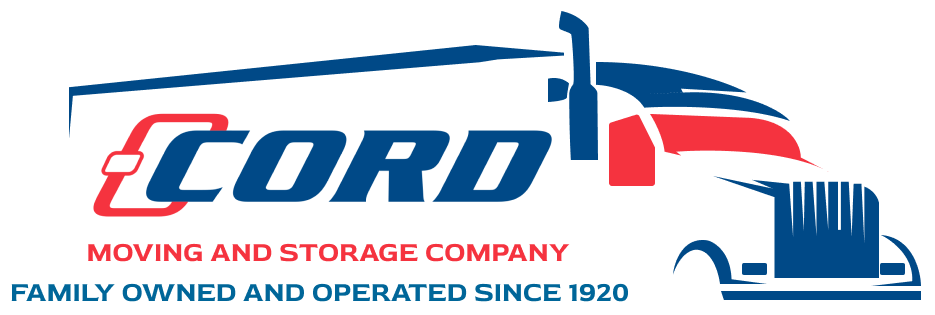Packing Tips for Moving
Moving Tips to Help You Start Packing for Moving Day!
Moving day is here! Before you start breaking out the cardboard boxes and garbage bags, it is important to prioritize. This will help you move into your new home and help our moving team move your belongings.
Packing Tips for Moving
Packing Clothes
Hanging clothing should be packed in wardrobe boxes available from Cord Moving and Storage. Folded clothing can remain in dresser drawers or packed in medium-sized boxes. Hats should be left in their boxes whenever possible or packed or wrapped loosely in packing paper and then placed in small boxes.
Packing Draperies / Curtains
Wardrobe cartons are excellent for moving curtains and drapes. These items can also be folded, wrapped in packing paper and packed in medium-sized/linen boxes.
Packing Mirrors / Paintings / Glass Tabletops / Wall Hangings
Special cartons are designed to carefully protect these items during the move. Only one item should be packed in each carton for safe handling. When Cord Moving and Storage pack these items, our skilled packers can double up and reduce your packing expense. Cord Moving and Storage provides professional assistance to crate oversized items or heavy furniture.
Packing Dishes / Plates / Flat China
Each item should be wrapped individually in packing paper. Then gather and bundle approximately three to six wrapped plates into one unit. Begin loading the box with larger items placing the smaller items toward the top. Place each bundle into the box on its side. NEVER lay them flat. Plates have greater strength when placed on their side. Once the bottom layer is finished add a few inches of crumpled paper and a cardboard divider, and you are set for the next layer.
Packing Bowls / Glass Bakeware
Just as with plates, wrap each bowl individually. Then to protect the bowls, nest 2 or 3 together and wrap as one bundle. These items can be placed on an end or laid flat. Next, create the second layer by using crumpled paper and a cardboard divider.
Packing Glassware / Barware / Crystal
Each piece should be individually wrapped in packing paper. Never put pieces inside one another. Place these items on the top level of your carton with the rim placed down. All fragile items should be packed in a separate carton and then packed into a larger carton for added protection.
Packing Glasses / Cups / Mugs
Each item should be wrapped individually and packed with rims down. Cup and mug handles should be cushioned with packing paper. Separate each layer with crumpled paper for added protection in the moving truck.
Packing Lamps / Shades
Always disassemble the lampshade from the base. Wrap the harp assembly and the base in packing paper and pack it in a dish pack or similar-type box. Select the carton size closest to the size of the shade measurements and pack only one shade per box. Use loose packing material to cushion the shade, but do not use crumpled packing paper inside or around the shade. Professional packing services should be used for all glass lampshades and chandeliers to ensure the safe delivery of those items.
Packing Small Electronics / Clocks / Small Appliances
Whenever available, the manufacturer’s packing is the best way to move electronic goods. If using another packaging, these items should be wrapped well and placed into a large or medium carton. Audio/visual and computer equipment requires special preparation prior to moving. Always consult your owner’s manual for specific instructions. Alert your Cord Moving and Storage relocation specialist to items that need special moving instructions.
Larger home electronics, such as large-screen televisions, should not be packed but moved as furniture. If you are moving flat-screen plasma television, alert your Cord Moving and Storage relocation specialist immediately for special moving instructions and potential crating. Computer systems, servers, grandfather clocks, etc. will require special preparation that should be discussed with your Cord Moving and Storage relocation specialist.
Packing Books
Pack books into smaller moving boxes alternating the bindings with the open edges. All books with fragile covers should be wrapped in packing paper for added protection.
Packing Food / Pantry Items
All dry foods can be packed into medium-sized cartons after taping any and all openings and closing all lids. Do not pack perishable items or aerosol cans.
Packing Plants / Flowers
Packing Refrigerators
For heavier items such as refrigerators, empty all contents and secure all shelving in place or remove and pack. The electronic Cord Moving and Storage should be taped to the back of the unit. All icemakers should be disconnected and drained several days in advance of the move.
-
Labeling the packages: Always label each carton with contents and the room in which it was packed. Always label the side, not the top of the carton.
Essential Packing Supplies strong packing boxes from Cord Moving and Storage bubble wrap for packing fragile items tissue and ink-free packing paper scissors utility knife for opening boxes several broad-tip markers to label boxes rolls of packing tape 3” wide
-
Perishables: food, plants or living things that may die or spoil in transit *
* You should empty your refrigerators and freezers and keep appliance doors open for at least 24 hours in advance of loading. This will allow appliances to dry out and prevent the growth of mold.
Items of Personal Importance or Sentimental Value
These items can create problems should your shipment be delayed or items lost. We suggest that irreplaceable items and/or sentimental items be carried with you instead of being packed with your shipment.
More Packing Tips
- Get more boxes than you think you will need.
- Get smaller boxes for books and larger boxes for lighter household items.
- Pack room-by-room, keeping similar items together.
- Reinforce the bottom of boxes with at least one strip of packing tape.
- Properly pack cartons firmly to prevent the contents from shifting during your move.
- Use crumpled paper for padding and seal boxes tightly with wide packing tape.
- Pack records, CDs and DVDs vertically. Never stack them flat.
- Use towels, linens, curtains, etc. to pad boxes of fragile items and label the boxes FRAGILE
- When disassembling furniture, beds, lamps, etc., put the hardware in a plastic bag along with any written assembly tips and tape it to the item itself.
- Make a box of essentials and label it “OPEN ME FIRST” so it is unloaded first or move it yourself.
- Essential items may include basic tools such as flashlights, pocket knives, hammers, screwdrivers, nails, masking tape, light bulbs, etc. bathroom essentials — hand towels, soap, toilet paper, shampoo, and shower curtains kitchen items — paper towels, coffeemaker, and filters, paper plates and cups, plastic utensils, pet foods, trash bags
Storage
If you are ready to move out but not ready to move into your new home or office, Cord Moving and Storage can help with the moving process. We provide clean, professional, short and long-term storage in modern, sanitized private vaults at affordable prices.
Each of our warehouses is equipped with state-of-the-art security systems and fire alarms with 24-hour central monitoring.
Cord Moving and Storage is one of the premier moving companies in the St. Louis and Memphis areas. Our professional movers will catalog each of your personal items — assets for inventory and list each individual item so you can verify the condition notes. If there are any concerns, our customer service specialists are standing by to help you with each step of your move.
Our mission is for our customers to have peace of mind that we will store their possessions as long as needed in a secure, cost-effective storage facility.


